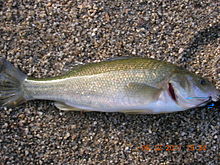The members of the family Percichthyidae are known as the temperate perches. They belong to the order Perciformes, the perch-like fishes.
| Temperate perches Temporal range:
| |
|---|---|

| |
| Percichthys trucha | |
| Scientific classification | |
| Domain: | Eukaryota |
| Kingdom: | Animalia |
| Phylum: | Chordata |
| Class: | Actinopterygii |
| Order: | Centrarchiformes |
| Suborder: | Centrarchoidei |
| Family: | Percichthyidae D. S. Jordan & C. H. Eigenmann, 1890[1] |
| Genera[2] | |
|
see text | |
| Synonyms | |
|
Gadopsidae | |

The name Percichthyidae derives from the Latin perca for perch and Ancient Greek ἰχθύς, ichthys for fish.
Evolution
editPotential percichthyid fossil remains are known from the Early Paleocene of the El Molino Formation of Bolivia; these remains have been described as resembling those of the fossil Percichthys hondoensis from the Eocene of Argentina. One articulated specimen is known from the Paleocene portion of the formation, but other remains are known from the Maastrichtian beds of the formation, indicating that percichthyids could have potential Cretaceous origins. However, the condition of this material is unclear. Another fossil percichthyid, Percichthys lonquimayiensis from Chile, was initially dated to the Paleocene, but further studies have found it to be from the Miocene.[3]
Classification
editThe temperate perches are closely related to the temperate basses of the family Moronidae, and older literature treats the latter as belonging to the family Percichthyidae. Australian freshwater percichthyids were once placed in the marine grouper family, Serranidae, and the two families are thought to be closely related.
Almost 40 species of percichthyids are now recognised, grouped in 11–12 genera. Most but not all are exclusively freshwater fishes. They are mainly found in Australia, but species are also found in southern South America (Percichthys).
More recently the Chinese perches have been classified in the separate family Sinipercidae while the genus Percilia has been found not to be closely related to either that family or the Percichthyidae and has been placed in its own monotypic family Perciliidae.[4]
The following 8 genera are classified within the family Percichthyidae:[4][2]
- Bostockia Castelnau, 1873
- Gadopsis Richardson, 1848
- Guyu Pusey & Kennard, 2001
- Maccullochella Whitley, 1929
- Macquaria Cuvier, 1830
- Nannatherina Regan, 1906
- Nannoperca Günther, 1861
- Percichthys Girard, 1855
Some workers have found that the genus Macquaria is polyphyletic and that the two catadromous species Macquaria colonorum and M. novemaculeata are not the closest relatives of the other two species in the genus and are placed in the genus Percalates in the monotypic family Percalatidae These authors also found that the Percichthyidae and the Percalatidae were part of one of three clades within a new order, the Centrarchiformes in the Percomorpha.[5]
Species
editAustralia has the greatest number of percichthyid species, where they are represented by the Australian freshwater cods (Maccullochella spp.), which are Murray cod, Mary River cod, eastern freshwater cod, and trout cod, by the Australian freshwater blackfishes (Gadopsis spp.), which are river blackfish and two-spined blackfish, and by the Australian freshwater perches which are golden perch, Macquarie perch (Macquaria spp.), and Australian bass, and estuary perch (Percalates spp.).
Several other Australian freshwater species also sit within the family Percichthyidae, while research using mitochondrial DNA suggests the species of the family Nannopercidae are in reality percichthyids, as well. Australia is unique in having a freshwater fish fauna dominated by percichthyids and allied families/species. This in contrast to Europe and Asia, whose fish faunas are dominated by members of the Cyprinidae carp family. (Australia does not have a single naturally occurring cyprinid species; unfortunately, the illegal introduction of carp has now established the family's presence in Australia.)
A single genus occurs outside Australia, Percichthys in southern South America.
A number of species are or have been important food species; some of these (e.g. the Murray cod, Maccullochella peelii peelii) have become threatened through overfishing and river regulation, while others are now farmed to some extent. Some smaller species (e.g. Balston's pygmy perch, Nannatherina balstoni) are popular in aquaria.
The extremely rare Bloomfield River cod, Guyu wujalwujalensis, is only found in a short stretch of the Bloomfield River in north Queensland.
Timeline
edit
See also
editReferences
edit- ^ Richard van der Laan; William N. Eschmeyer & Ronald Fricke (2014). "Family-group names of Recent fishes". Zootaxa. 3882 (2): 001–230.
- ^ a b Froese, Rainer; Pauly, Daniel (eds.). "Family Percichthyidae". FishBase. December 2019 version.
- ^ Friedman, Matt; V. Andrews, James; Saad, Hadeel; El-Sayed, Sanaa (2023-06-16). "The Cretaceous–Paleogene transition in spiny-rayed fishes: surveying "Patterson's Gap" in the acanthomorph skeletal record André Dumont medalist lecture 2018". Geologica Belgica. doi:10.20341/gb.2023.002. ISSN 1374-8505.
- ^ a b J. S. Nelson; T. C. Grande; M. V. H. Wilson (2016). Fishes of the World (5th ed.). Wiley. p. 442. ISBN 978-1-118-34233-6.
- ^ Sébastien Lavoué; Kouji Nakayama; Dean R. Jerry; et al. (2014). "Mitogenomic phylogeny of the Percichthyidae and Centrarchiformes (Percomorphaceae): comparison with recent nuclear gene-based studies and simultaneous analysis". Gene. 549 (1): 46–57. doi:10.1016/j.gene.2014.07.033. Abstract
- "Percichthyidae". Integrated Taxonomic Information System. Retrieved 8 February 2011.
- Sepkoski, Jack (2002). "A compendium of fossil marine animal genera". Bulletins of American Paleontology. 364: 560. Retrieved 2011-05-19.